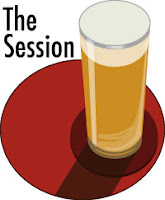 I happened to be in the UK when Boak and Bailey announced that they were hosting the 88th round of The Session. Unfortunately I wasn't in one of the good bits, so my plans to pick some new-to-me British beers in traditional styles for mixing was somewhat scuppered by the awful selection at Sainsbury's in Armagh, itself the nearest thing to a decent off licence open in the town on a Sunday.
I happened to be in the UK when Boak and Bailey announced that they were hosting the 88th round of The Session. Unfortunately I wasn't in one of the good bits, so my plans to pick some new-to-me British beers in traditional styles for mixing was somewhat scuppered by the awful selection at Sainsbury's in Armagh, itself the nearest thing to a decent off licence open in the town on a Sunday.The best I could do was two of the Greene King IPA brand extensions, and though I don't see IPA and IPA on the list of traditional mixes, I reckon these two are different enough from each other to yield a meaningful result.

But first, to try them separately so I know what I'm dealing with. Greene King IPA Gold is a 4.1% ABV golden ale. There's a very pleasant honeyish aroma to begin with, followed by a floral meadowy flavour. It's on the sweet side, but not overly so, with a definite lagery crispness to it as well. It's simple and clean but without being boring and only just a little bit skunked through the daft clear glass. As a beer for drinking cold while outdoors on a sunny day it's nothing to be afraid of.
Greene King IPA Reserve is almost as different as a beer with more-or-less the same name can be. It's a dark copper colour and smells of ripe forest fruits, blackberries and damsons in particular. There's more of a summery quality on tasting, with strawberry and raspberry coming through, though nary a sign of a hop in all this. The caramel stickiness does start to get a bit much, but there's enough of a tannic element to keep it just about drinkable. Overall it's harder work than the Gold.
My hope for combining them was that I'd get the fresh cleanness of the Gold coupled with the fruit and dry tannins of the Reserve while thinning down the sugariness of the latter. Is this something real people might do in a real pub if such practices were still socially acceptable? Yes, maybe.
 The result is closer in colour to Reserve than Gold, just a little bit paler. And the flavour combination does actually sort-of work: the floral honey element is the first thing to come through, but instead of a simple lager-fizz base, it's sitting on the summer fruits from the Reserve, conjuring a marvellously bucolic picture of copse-smattered rolling downs. English with a capital E. You can almost hear the birdsong. The tannins haven't quite disappeared but only flash briefly right at the very end. But it's neither sticky nor watery and actually quite a decent, balanced complex English session bitter. I really didn't want to use the hackneyed "greater than the sum of its parts" in this review, but it's apt nonetheless.
The result is closer in colour to Reserve than Gold, just a little bit paler. And the flavour combination does actually sort-of work: the floral honey element is the first thing to come through, but instead of a simple lager-fizz base, it's sitting on the summer fruits from the Reserve, conjuring a marvellously bucolic picture of copse-smattered rolling downs. English with a capital E. You can almost hear the birdsong. The tannins haven't quite disappeared but only flash briefly right at the very end. But it's neither sticky nor watery and actually quite a decent, balanced complex English session bitter. I really didn't want to use the hackneyed "greater than the sum of its parts" in this review, but it's apt nonetheless.A fun experiment with an unexpected result. I will leave this post in the hope that someone seeking advice on what to do with two Greene King IPA offshoots they have acquired, but aren't especially keen on drinking, will find it and benefit as I have.





Reckon this might qualify as a 'lightplater' -- bitter and light ale. At any rate, perfectly in the spirit of the thing.
ReplyDeleteBacks up our findings: two one-dimensional beers can gain a third dimension when mixed.
There's a whole new level of style prescriptivism available here.
Deletewhat about emersons? they are supposed to have a good range of beer....ah closed on a sunday i see.
ReplyDeleteI assure you I gave the door a bit of a rattle even though I knew it was closed and could see it was closed.
Delete